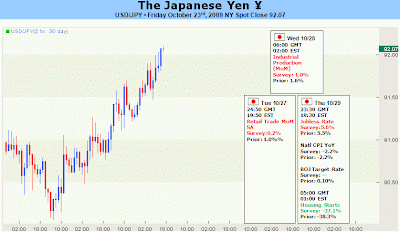
The British pound racked up heavy losses on Friday, tumbling 1 percent against the Japanese yen and nearly 2 percent against the US dollar, after UK GDP unexpectedly showed that the nation did not emerge from recession during Q3, and instead, the economy contracted for the sixth straight quarter at a rate of -0.4 percent. Likewise, the annual rate of growth edged up to -5.2 percent from -5.5 percent, falling short of expectations for a move to -4.6 percent. A breakdown of the GDP report showed that nearly every UK business sector remained in recession, as the services industry component fell by 0.2 percent while the production industry component tumbled 0.7 percent.
Going forward, it’s worthwhile to note that GDP is a lagging indicator and the release’s impact on interest rate expectations is the most important part. Indeed, the British pound fell sharply because Credit Suisse overnight index swaps shifted to price in a 10 percent chance of a 25 basis point cut by the BOE during their next meeting. Furthermore, expectations for rate increases over the next 12 months fell to 88.1 basis points from 93.4 basis points. While the BOE hasn’t really given any indication of their collective stand on quantitative easing (QE) at this juncture, we do know that the Monetary Policy Committee (MPC) is looking for reasons to justify either winding down or expanding their target level of asset purchases. The minutes from their October policy meeting showed that the "forecast round ahead of the November Inflation Report would provide an opportunity to assess more fully how the medium-term outlook for activity and inflation had evolved since August," and if the latest economic data has any bearing on the MPC’s bias, it looks there is still some bearish potential for the British pound.
Looking ahead to the next week, UK data shouldn’t have too much of an impact on rate expectations, but there is always the lingering risk that BOE MPC members will make comments that could impact trade. Thursday is really the only day with scheduled indicators on hand. Net consumer credit in the UK is anticipated to remain negative for the third straight month at -0.2 billion pounds, but on the other hand, UK mortgage approvals are projected to hit a more than one-year high of 53,600, suggesting that lending levels remain low but housing demand is growing. Meanwhile, GfK consumer confidence is forecasted to climb to a nearly two-year high of -14 from -16, indicating that sentiment is still pessimistic but improving, albeit at a slow pace. All told, where GBPUSD goes in the coming week will likely have more to do with US dollar trends than UK fundamental forces, but a break below the 50 SMA at 1.6265 opens the door to much steeper declines. – TB









